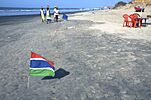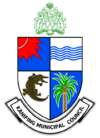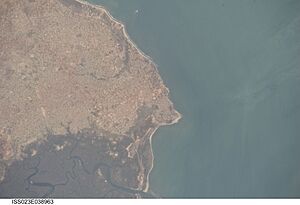Kanifing facts for kids
Quick facts for kids
Kanifing
|
||
|---|---|---|
|
Urban municipality
|
||
|
|
||
|
||

Location of the Kanifing Local Government Area in the Gambia
|
||
| Country | The Gambia | |
| Local government area | Kanifing | |
| District | Kanifing | |
| Government | ||
| • Type | Mayor–council government | |
| • Body | Kanifing Municipal Council | |
| Area | ||
| • Land | 75.5 km2 (29.2 sq mi) | |
| Population
(2013)
|
||
| • Total | 382,096 | |
| • Estimate
(2023)
|
391,270 | |
| Website | http://kanifing.gm/ | |
Kanifing is an important urban area in the Gambia. It is a municipality, which means it has its own local government. It is part of the Greater Banjul Area, located just west of the capital city, Banjul. The Kanifing Municipal Council helps run the area.
Kanifing is the most populated district in the Gambia. It is also one of the most crowded places in the country. Many people have moved here from other parts of the Gambia and from other countries. This has made it a very diverse place with many different ethnic groups.
This area is also the economic heart of the Gambia. Serekunda, the largest city in the country, is located here. Tourism is a big industry, bringing many visitors. Kanifing also has several important colleges and universities, including the University of the Gambia.
Contents
A Look at Kanifing's History
Kanifing has grown a lot over the years. It started with small settlements and became a busy urban area.
Early Settlements
In the 1800s, a person named Sayerr Jobe founded Serekunda. This was the first settlement in what was then a forested area. He also helped start other towns in Kanifing, like Bundung and Ebo Town.
How Kanifing Grew
The area that is now Kanifing was once called British Kombo. It was given to Britain by France in 1840. Later, it became part of the Gambia Colony. In the 1960s, it became the Kombo St. Mary local government area (LGA).
Over time, its name changed. In 1974, it became the Kanifing Urban District Council. Then, in 1991, it was renamed the Kanifing Municipal Council.
Kanifing grew very quickly after the Gambia became independent. Many people moved here, including those from nearby countries. This growth helped the country's cities become bigger. It also led to more foreign investment and higher property values.
Understanding Kanifing's Geography
Kanifing is a unique part of the Gambia. It is one of the country's eight local government areas.
The area covers about 75.5 square kilometers. It is located right next to Banjul, the capital city. Together, these two areas form the Greater Banjul Area. Serekunda, the Gambia's largest urban area, is found within Kanifing.
Who Lives in Kanifing?
Kanifing is the most populated and most crowded district in the Gambia.
Population Growth
In 2013, the population of Kanifing Municipality was 377,134 people. By 2023, it was estimated to be around 391,270 people. The population has grown a lot over the decades:
- 1963: 12,208 people
- 1973: 39,404 people
- 1983: 101,504 people
- 1993: 228,214 people
- 2013: 377,134 people
Diverse Communities
Many different ethnic groups live in Kanifing. For example, a large number of Mandinka people moved to cities like Kanifing. In 1993, Kanifing was home to about one-third of the country's Jola people. It also had many Serahuli people and Serer people.
Kanifing is also home to many immigrants. In 2013, about 30% of all immigrants in the Gambia lived here. Many came from Senegal and Guinea. In multi-ethnic groups in Kanifing, the Wolof language is often used for communication. This is different from the rest of the country, where Mandinka is more common.
Main Towns and Villages
Kanifing has many towns and villages. Some of the larger ones include:
- Bundungka Kunda
- Faji Kunda
- Ebo Town
- Bakau New Town
- Talinding
- Abuko
- Dippa Kunda
- Bakoteh
- Manjai Kunda
- Latri Kunda German
- Latri Kunda Sabiji
- New Jeshwang
- Serekunda
How Kanifing is Managed
The Kanifing Municipal Council (KMC) manages the area. It is led by the Lord Mayor of Kanifing.
Local Government Structure
The KMC is divided into eighteen smaller areas called wards. Each ward has councilors who help with local issues. These wards include Abuko, Bakau New Town, Bakoteh, and Kololi. The municipality also has seven areas that elect representatives to the parliament.
Kanifing's Economy
Kanifing is the main business hub of the Gambia. It has the most industries in the country.
Jobs and Industries
Many people in Kanifing work in the private sector. A large number of jobs are in buying and selling goods (wholesale and retail trade). Manufacturing and services also provide many jobs.
The area is also a major tourist destination. Most of the Gambia's hotels and beach resorts are located here. The national football stadium, Independence Stadium, is also in Kanifing.
Helping People Find Homes
The local government has plans to build 8,000 affordable homes. This project aims to help more people find places to live.
Important Infrastructure
Kanifing has important services and facilities for its residents.
Managing Waste and Recycling
The Kanifing Municipal Council is in charge of managing waste. Its Environment and Sanitation Unit (ESU) cleans streets and collects trash. They also clear illegal dump sites. The KMC spends a lot of its budget on waste management.
The Bakoteh Dumpsite is the largest dump in the Gambia. It collects all the waste from the Greater Banjul Area. The city is working on new ways to manage waste, like turning old dumps into transfer stations. They are also trying to compost organic waste and turn it into fuel.
The Mbalit project helps collect household waste. It uses a digital system for payment. Each ward has a garbage truck that collects waste weekly. Some informal collectors also use donkey carts to help. The mayor has made waste management a top priority. They have a five-year plan to improve waste collection and recycling. This plan includes educating the public and creating new jobs.
Transportation in Kanifing
Kanifing is a hub for transport. The Gambia Transport Service Company has a bus station here. You can even catch international buses to cities like Dakar in Senegal and Bissau in Guinea-Bissau.
The local government also plans to create a new city bus system. It will have fifty buses and twenty different routes to help people get around easily.
Education and Learning
Kanifing is a center for higher education in the Gambia.
Colleges and Universities
Most of the country's colleges and universities are located here. These include:
- University of The Gambia
- American International University West Africa
- Gambia Technical Training Institute
- Management Development Institute
A New Library
A new municipal library is being built in Kanifing. This will be the first city library in the country. It is a project supported by the mayor and funded by partners like the Peterborough City Council in England.
Sports in Kanifing
The Kanifing Municipal Sports Committee (KM Sport) helps organize sports in the area. It is one of the seven regional sports groups in the Gambia. The chairperson of KM Sport represents Kanifing in the National Sports Council.
Kanifing's Sister Cities
Kanifing has special partnerships with cities in other countries. These are called sister cities.
 Madison, Wisconsin, United States
Madison, Wisconsin, United States Mbao, Senegal
Mbao, Senegal
Madison, for example, has helped Kanifing by providing money for garbage trucks and the new public library.
External Websites
- Government of Kanifing







